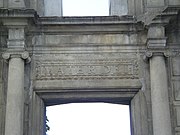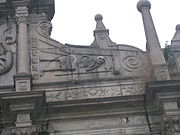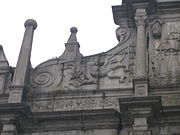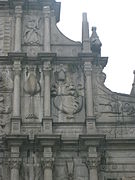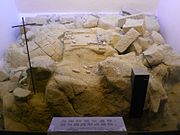Ruins of Saint Paul's

| Ruins of Saint Paul's | |||||||||||||
|---|---|---|---|---|---|---|---|---|---|---|---|---|---|
| Chinese name | |||||||||||||
| Chinese | 大三巴牌坊 | ||||||||||||
| |||||||||||||
| Portuguese name | |||||||||||||
| Portuguese | Ruínas de São Paulo | ||||||||||||
The Ruins of Saint Paul's (Chinese: 大三巴牌坊; Portuguese: Ruínas de São Paulo) are the ruins of a 17th-century Catholic religious complex in Santo António, Macau, China. They include what was originally St. Paul's College and the Church of St. Paul (Igreja de São Paulo) also known as "Mater Dei", a 17th-century Portuguese church dedicated to Saint Paul the Apostle. Today, the ruins are one of Macau's best known landmarks and one of the Seven Wonders of Portuguese Origin in the World. In 2005, they were officially listed as part of the Historic Centre of Macau, a UNESCO World Heritage Site.
History
Built from 1602 to 1640[1] by the Jesuits, during the time in which Portugal and Spain were under the same crown, the church was one of the largest Catholic churches in Asia at the time. It was destroyed by a fire during a typhoon on 26 January 1835.[1] The Fortaleza do Monte overlooks the ruin.

The ruins now consist of the stone frontispiece.[2]: 121 The façade sits on a small hill, with 68 stone steps leading up to it.
The façade is shaped like a retable and themed around the Assumption of Mary.[2]: 122 Likely influenced by Japanese Christian craftsmen who worked on it, the ruins of St. Paul's include carvings with heterodox images that draw from Asian traditions, including Mary stepping on a seven-headed hydra, described in accompanying Chinese characters as "Holy Mother tramples the heads of the dragon".[2]: 122 The base of the structure has six Chinese guardian lions carved from stone.[2]: 122
The Japanese Christian craftsmen who worked on St. Paul's were converted by Jesuits and expelled from Japan in 1587 when Toyotomi Hideyoshi banned Christianity.[2]: 122
The remains of around 250 Korean and Japanese slaves from the Portuguese slave trade are buried near the church.[3]
Conservation
Resisting calls for the dangerously leaning structure to be demolished, from 1990 to 1995, the ruins were excavated under the auspices of the Instituto Cultural de Macau to study its historic past.[citation needed] The crypt and the foundations were uncovered, revealing the architectural plan of the building. Numerous religious artifacts were also found together with the relics of the Chinese Christian martyrs and the monastic clergy, including the founder of the Jesuit college in Macau, Father Alessandro Valignano.[citation needed]
The ruins were restored by the Macanese government into a museum, and the façade is now buttressed with concrete and steel in a way which preserves the aesthetic integrity of the façade.[citation needed] There was once a steel stairway that allowed tourists to climb up to the top of the façade from the rear, but due to concerns for the preservation of the church, tourists are no longer allowed to climb up.
See also
References
 Media related to Ruins of St. Paul's at Wikimedia Commons
Media related to Ruins of St. Paul's at Wikimedia Commons- 192183185 Ruins of Saint Paul's on OpenStreetMap
- ^ a b "China". The Morning Post. British Newspaper Archive. 8 July 1835. Retrieved 16 July 2014.
- ^ a b c d e Simpson, Tim (2023). Betting on Macau: Casino Capitalism and China's Consumer Revolution. Globalization and Community series. Minneapolis: University of Minnesota Press. ISBN 978-1-5179-0031-1.
- ^ KBS 역사추리 – 임진왜란은 노예전쟁이었다 2부 / KBS 19960913 방송, 1996-09-13, event occurs at 12:41, retrieved 2024-02-09
Gallery
-
 The ruins of the original clock tower and cloister were opened into roads.
The ruins of the original clock tower and cloister were opened into roads. -
 Stone carvings and bronze statues on the archway of the St. Paul's.
Stone carvings and bronze statues on the archway of the St. Paul's. -

-
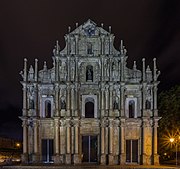
-

-
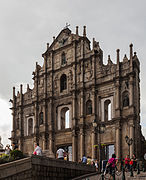
-
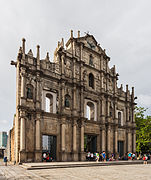
- St Paul's Ruins from St Paul's Hill, Macau
-
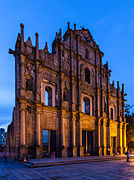 At sunset
At sunset -
 Façade of the Mother-of-God church
Façade of the Mother-of-God church -

-
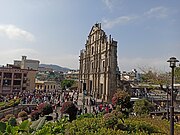
-

-
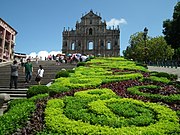
-
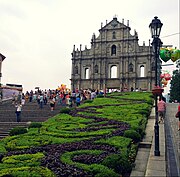 Ruins of St. Paul's Cathedral
Ruins of St. Paul's Cathedral -
-
 Panorama of Ruins of St Paul's from the front of façade.
Panorama of Ruins of St Paul's from the front of façade. -
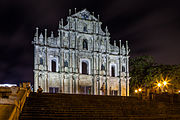
-
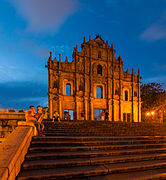 Remains of the Cathedral of Saint Paul, Macau
Remains of the Cathedral of Saint Paul, Macau -
 Remains of the Cathedral of Saint Paul, Macau at sunset
Remains of the Cathedral of Saint Paul, Macau at sunset -
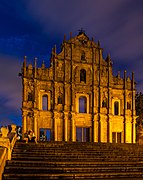
-
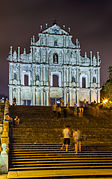
-

-
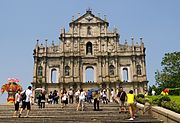
-
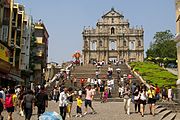
- The back of the Ruins of St. Paul's, behind the façade are remains of the original pillars and a shrine.
-
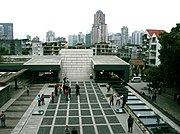 The former church room, photographed from the first floor of the façade.
The former church room, photographed from the first floor of the façade. - Back of the façade with the stairs for visitors
-
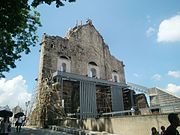
-
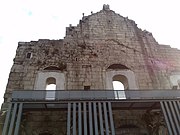
-
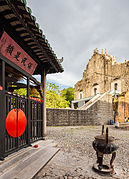
-
 The emblem of the Jesuit Order on the Ruins of the St. Paul.
The emblem of the Jesuit Order on the Ruins of the St. Paul. - This is the entry of Cathedral of Saint Paul in Macau. "MATER DEI" is engraved on the front door, which means "Mother of God".
-
 The foundation stone, laid in 1602, under the front wall (i.e. the Archway) of St. Paul’s Church. The inscription "VIRGINI MAGNÆ MATRI CIVITAS MACAENSIS LIBENS POSVIT·AN·1602", which can be interpreted as: "The City of Macau built this Church in honour of the Great Virgin Mother in the year 1602".
The foundation stone, laid in 1602, under the front wall (i.e. the Archway) of St. Paul’s Church. The inscription "VIRGINI MAGNÆ MATRI CIVITAS MACAENSIS LIBENS POSVIT·AN·1602", which can be interpreted as: "The City of Macau built this Church in honour of the Great Virgin Mother in the year 1602". -
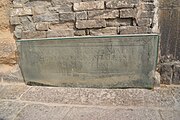
-
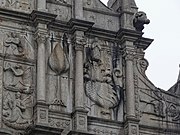 Detail from the Saint Paul church ruins in Macau. The carvings include Jesuit images with Oriental themes, such as The Blessed Virgin Mary stepping on a seven-headed hydra, described in Chinese characters as 'Holy Mother tramples the heads of the dragon'.
Detail from the Saint Paul church ruins in Macau. The carvings include Jesuit images with Oriental themes, such as The Blessed Virgin Mary stepping on a seven-headed hydra, described in Chinese characters as 'Holy Mother tramples the heads of the dragon'. -

-

-

-
-

-

-
-
-
-
-
-
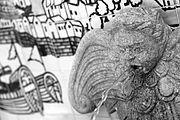
-
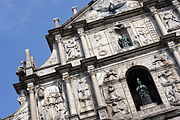
-

-
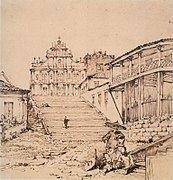 St. Paul’s College and Church before the fire in 1834. It can be seen that most of the buildings of the College and Church, including the bell tower, still exist, painted by George Chinnery.
St. Paul’s College and Church before the fire in 1834. It can be seen that most of the buildings of the College and Church, including the bell tower, still exist, painted by George Chinnery. -
 Ruins of the main altar of the church after the fire. Painted by Chanary in 1835.
Ruins of the main altar of the church after the fire. Painted by Chanary in 1835. -
 The St. Paul's archway in 1870, photographed by John Thomson.
The St. Paul's archway in 1870, photographed by John Thomson. -
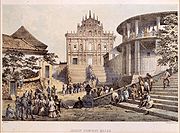 The façade of St. Paul's Church by Wilhelm Heine, 1854
The façade of St. Paul's Church by Wilhelm Heine, 1854 -
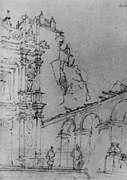 After the Great Fire of 1835, the cloister next to the church survived and the bell tower next to it was badly damaged.
After the Great Fire of 1835, the cloister next to the church survived and the bell tower next to it was badly damaged. -
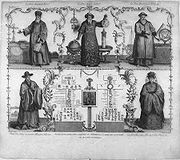 Some scholars who passed through the College: Matteo Ricci (left), Adam Schall (center), Ferdinand Verbiest (right); below Xu Guangqi and his granddaughter Candide Hiu
Some scholars who passed through the College: Matteo Ricci (left), Adam Schall (center), Ferdinand Verbiest (right); below Xu Guangqi and his granddaughter Candide Hiu -
 Jesuit missionary Ferdinand Verbiest. This is an enlargement of a part of the image that is to the left.
Jesuit missionary Ferdinand Verbiest. This is an enlargement of a part of the image that is to the left. -
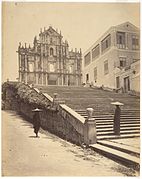 1869
1869 -
 1 October 1908
1 October 1908 -
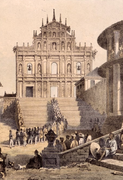 1854
1854
-
 The ruins of the main altar no longer exist and are now the Museum of Sacred Art and Crypt
The ruins of the main altar no longer exist and are now the Museum of Sacred Art and Crypt - Entrance to the museum
-
 The original Inner Harbor view on the St. Paul's archway is obscured by modern buildings, and the statue of Matteo Ricci is on the lower right.
The original Inner Harbor view on the St. Paul's archway is obscured by modern buildings, and the statue of Matteo Ricci is on the lower right. -
 Looking at the ruins of St. Paul's Cathedral, St. Paul’s archway, stone steps and inner harbor from the Fortress in 1955
Looking at the ruins of St. Paul's Cathedral, St. Paul’s archway, stone steps and inner harbor from the Fortress in 1955 -
22°11′51″N 113°32′26″E / 22.19750°N 113.54056°E / 22.19750; 113.54056
- v
- t
- e
- Luís de Camões Garden
- Casa Garden
- Fire Services Museum
- Mount Fortress
- Kiang Wu Hospital
- Macau Protestant Chapel
- Museum of Macau
- Museum of Sacred Art and Crypt
- Na Tcha Temple
- Old Protestant Cemetery
- Ruins of Saint Paul's
- Sofitel Macau at Ponte 16
- Colégio Mateus Ricci
- Chan Sui Ki Perpetual Help College Branch Campus
- Kwong Tai (Guang Da) Middle School Branch Campus
| Closed |
|---|



































